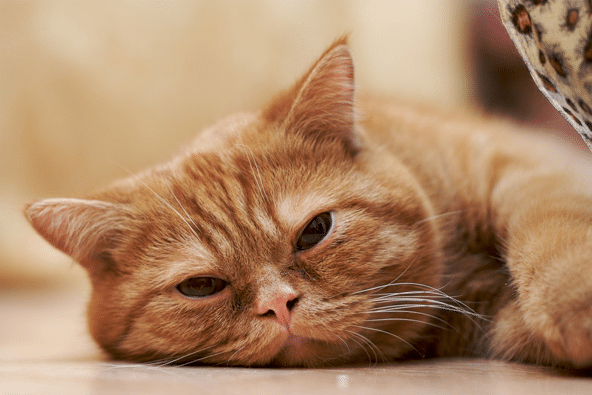What Are Cat Constipation Remedies?
Cat Constipation: Mild, occasional constipation is common in cats and is usually nothing to worry about. But how do you know when it becomes a serious problem, requiring the attention of a veterinarian? Learn the causes, remedies, and medical issues related to your cat’s constipation.
“Your cat should be producing stool about once a day,” says Liz Bales, VMD. “A healthy stool has enough moisture that litter will stick to it. If your cat has not produced stool for 48 – 72 hours, [he] may be constipated. You may notice dry, hard feces inside or outside the litter box. Some other signs to look for might be decreased appetite and water intake, vomiting, hiding, and crying or straining while trying to defecate.”

Cat Constipation Massage
Cat Poop: What’s Normal?
Most cats will poop at least once a day. If they’re healthy, their poop should:
- Be deep brown in color
- Feel not too hard or too soft or mushy
- Not smell too foul, though some odor is normal
Diarrhea
Diarrhea is not uncommon for cats, and there are many reasons why your cat might have it. Sometimes, it comes and goes quickly. Other times, it can last for days, weeks, or months, or come back on a regular basis.
Diarrhea that lasts for 24 to 48 hours probably won’t cause a problem unless you have an older cat or a kitten. But if it lasts longer, your cat can get dehydrated, which can be dangerous.
Some common causes of cat diarrhea include:
- Changes to their diet or food allergies or intolerances
- Inflammatory bowel disease
- Colitis
- Worms (intestinal parasites)
- Pancreatic disease
- Cancer
- Hyperthyroidism
If your cat has diarrhea that lasts more than a day or two, see your veterinarian to figure out the cause. Call your vet right away if the diarrhea is black or bloody, or if it happens along with fever, vomiting, sluggishness, or a loss of appetite.
To prevent diarrhea, don’t give your cat dairy products like milk or yogurt — many cats can’t digest them properly. Also, if you switch the brand or type of food you give him, be sure to introduce it over several days by mixing it with smaller and smaller amounts of the old food until he’s eating only the new stuff.
How To Palpate A Cat For Constipation

First, constipation is not a pleasant experience for any cat. Second, repeated episodes of constipation can cause irreversible enlargement of the colon. Serious constipation can lead to a condition where the cat cannot expel stools at all, and needs an enema. At worst, a cat can be so blocked up or “impacted,” and the colon so enlarged, that surgery is the only option.
What causes constipation in cats?
The most common causes of feline constipation are:
- Dehydration
- Painful defecation
- Stress in the home
- A dirty litter box
- A disease
Identifying the cause is not always easy, but it’s important so that we can manage constipation and reduce the chances of it worsening. A thorough discussion with your family vet will help you determine the cause.
Your vet may ask:
- Was there a change in diet?
- Was there a change in water intake?
- Is your cat on any medication?
- Are there any painful joints that might keep your cat from reaching the litter box?
- Is there excessive licking or grooming?
- Could it be a litter box issue?
- Was the type of litter changed?
- Is the litter box cleaned often enough?
- Are there multiple cats and not enough litter boxes?
- Is there a source of stress in the household, such as a new cat or a new dog?
How can you prevent constipation in cats?
Here are several ways to decrease the risk of constipation in cats:
is an easy way to increase water intake. Dry food may contain about 10-20% water, whereas canned food may have 80%
- Make sure there are multiple litter boxes if you have several cats
- Clean each litter box at least once daily
- Different cats prefer different types of litter. Make sure your cat seems happy with the litter you choose
- Discuss a daily laxative with your veterinarian
- Increase exercise and playful activities
What are the signs of constipation in cats?
Constipated cats may be seen straining in the litter box. When in pain, constipated cats may vocalize during defecation. They often have decreased thirst and appetite. Constipation can also cause vomiting.
It is important to differentiate constipated cats from cats with a urinary blockage. At first glance, they may look the same: straining in the litter box. However, from a medical standpoint, the two conditions are radically different.
Cat Constipation Olive Oil
Straining in the litter box—possibly even crying out or leaving unwelcome hard pellets around the home—constipated felines are uncomfortable. And constipation can interfere with a cat’s appetite and even result in vomiting. Traditional approaches to this hard problem include administering enemas, laxatives to soften the stool or increase contractions, dietary fiber, and promotility agents. Could we be missing something really basic? And when should we be concerned about the long-term effects of constipation?
Constipation is a clinical sign that is not pathognomonic for any particular cause. Most commonly, constipation is a result and a sign of dehydration. The body is 65% to 75% water, depending on a cat’s age and percent body fat. Homeostasis attempts to maintain a consistent cellular and extracellular environment. When cells become dehydrated, the body takes steps to correct the fluid deficit. Drinking more and concentrating urine is helpful, but once those capabilities have been maximized, water is reabsorbed in the colon, resulting in the drier stool that is harder to pass. Bearing this in mind, medical therapy might not be the best initial therapeutic approach.
Other causes of constipation include problems that result in obstruction (either mechanical or functional), painful defecation, stress within the home environment (social or a dirty toilet), and possibly metabolic disease
Cat Constipation Remedy
When my tabby Piper, prone to constipation, didn’t respond well to a vet-prescribed laxative — he literally made a face at the taste — I was desperate to find a better alternative. I’d heard that some cats will eat canned pumpkin, a good source of fiber. I dutifully prepared “cat meatballs,” coating a dollop of pumpkin in Piper’s food to hide this helpful surprise in the center. He accepted it, and the daily serving kept him regular for his remaining years. My kitchen cabinets were quickly filled with a disaster-level stash of canned pumpkin.
While this worked for me, since constipation can be a symptom of more serious problems, such as rectal obstruction or diabetes, a constipated cat should always be examined by a vet first. If untreated, constipation can lead to the cat’s colon losing its elasticity. Here’s what you need to know to help your cat “go”:
Causes of Feline Constipation
Cats get constipated for a variety of reasons: lack of exercise, too little water, or by swallowing too much hair when they groom. Ingested bones, string, or other foreign objects can cause colon blockage, preventing the cat’s elimination. Too little fiber can cause constipation, but so can too much — because fiber absorbs water and causes retention of stool. Sometimes a cat that shares a litter box won’t use it because of another cat’s aggression. Cats may also get constipated from an environment change, such as a move to a new home, being hospitalized, or visiting an unfamiliar place such as a vacation house.
Signs and Symptoms
The most obvious tip-off that a cat is constipated is straining to defecate. A mildly constipated cat may cry as he attempts to “go,” then pass only small amounts of watery feces. In more severe cases, the cat may squat in his litter box for an abnormally long period, passing either no feces or hard, small stools. He may also pass a bit of bloody diarrhea. Constipated cats may also try to poop outside the litter box, or repeatedly return to it with just a short time between visits. They’ll crouch and strain, but produce nothing. The cat will seem lethargic, with a poor appetite, and he may lose weight. You may also notice vomiting, and a hunched, unnatural posture, while sitting or walking, due to discomfort.
Is the cat constipation an emergency?
What is a natural laxative for cats?
How do you Unconstipate a cat?
- Fluids, IV or under the skin (rehydration)
- Manual removal of stools, along with an enema (from your veterinarian)
- A diet change, that is rich in fibers.
- A laxative.
- Drugs (called promotility drugs) to move food and fecal matter “downward”


